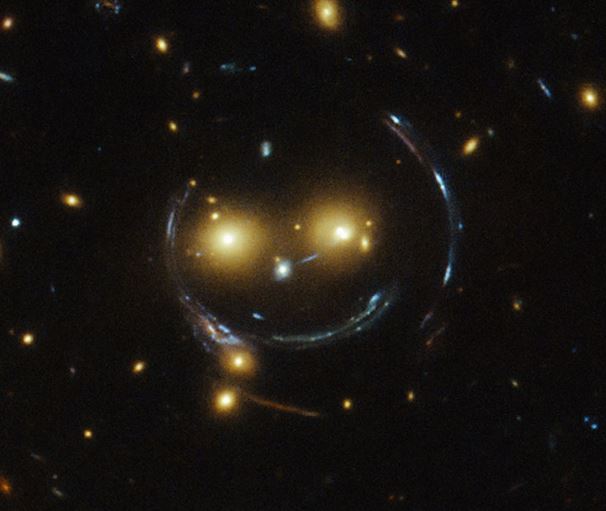The Hubble Space Telescope took a picture of what looks like a smiley emoticon in deep space. It is, in fact, the galaxy cluster SDSS J1038+4849 with some of its celestial bodies lined up and light rays bending in such a way to suggest a smiling face.
In the picture you can make out two orange-colored eyes and a white button nose. The two eyes are extremely bright galaxies, while what seems to be a smiling mouth are really arcs caused by strong gravitational lensing.
A gravitational lens is formed when the light from a very bright, distant object is “bent” around a massive object such as a huge galaxy between the viewer and the bright object. Gravitational lensing was one of the predictions made by Einstein’s theory general relativity.

The galaxy cluster SDSS J1038+4849 seems to be smiling. (Image: spacetelescope.org)
Galaxy clusters are the Universe’s most massive structures. They exert such a gravitational pull that they warp the spacetime around them.
As far as light is concerned, this powerful pull acts as a cosmic lens which can distort, magnify and bend it.
According to the European Space Agency:
“In this special case of gravitational lensing, a ring — known as an Einstein Ring — is produced from this bending of light, a consequence of the exact and symmetrical alignment of the source, lens and observer and resulting in the ring-like structure we see here.”
The Hubble Space Telescope has provided astrophysicists with tools to probe these giant galaxies, allowing them to peer deeper into the early Universe than ever before.
This “smiley” object was studied by Hubble’s WFPC2 (Wide Field and Planetary Camera 2) and WFC3 (Wide Field Camera 3). The study formed part of a survey of strong lenses.
Judy Schmidt entered a version of this image into the Hubble’s Hidden Treasures image processing competition.
